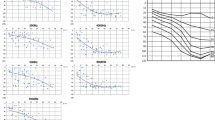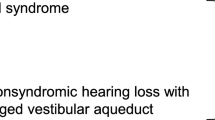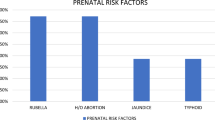Abstract
Pathogenic mutations of MARVELD2, encoding tricellulin, a tricelluar tight junction protein, cause autosomal recessive non-syndromic hearing loss (DFNB49) in families of Pakistan and Czech Roma origin. In fact, they are a significant cause of prelingual hearing loss in the Czech Roma, second only to GJB2 variants. Previously, we reported that mice homozygous for p.Arg497* variant of Marveld2 had a broad phenotypic spectrum, where defects were observed in the inner ear, heart, mandibular salivary gland, thyroid gland and olfactory epithelium. The current study describes the types and frequencies of MARVELD2 alleles and clinically reexamines members of DFNB49 families. We found that MARVELD2 variants are responsible for about 1.5 % (95 % CI 0.8–2.6) of non-syndromic hearing loss in our cohort of 800 Pakistani families. The c.1331+2T>C allele is recurrent. In addition, we identified a novel large deletion in a single family, which appears to have resulted from non-allelic homologous recombination between two similar Alu short interspersed elements. Finally, we observed no other clinical manifestations co-segregating with hearing loss in DFNB49 human families, and hypothesize that the additional abnormalities in the Marveld2 mutant mouse indicates a critical non-redundant function for tricellulin in other organ systems.



Similar content being viewed by others
References
Abeysinghe SS, Chuzhanova N, Krawczak M, Ball EV, Cooper DN (2003) Translocation and gross deletion breakpoints in human inherited disease and cancer I: nucleotide composition and recombination-associated motifs. Hum Mutat 22:229–244. doi:10.1002/humu.10254
Ahmed ZM, Riazuddin S, Bernstein SL, Ahmed Z, Khan S, Griffith AJ, Morell RJ, Friedman TB, Riazuddin S, Wilcox ER (2001) Mutations of the protocadherin gene PCDH15 cause Usher syndrome type 1F. Am J Hum Genet 69:25–34. doi:10.1086/321277
Ben-Yosef T, Belyantseva IA, Saunders TL, Hughes ED, Kawamoto K, Van Itallie CM, Beyer LA, Halsey K, Gardner DJ, Wilcox ER, Rasmussen J, Anderson JM, Dolan DF, Forge A, Raphael Y, Camper SA, Friedman TB (2003) Claudin 14 knockout mice, a model for autosomal recessive deafness DFNB29, are deaf due to cochlear hair cell degeneration. Hum Mol Genet 12:2049–2061
Borck G, Ur Rehman A, Lee K, Pogoda HM, Kakar N, von Ameln S, Grillet N, Hildebrand MS, Ahmed ZM, Nurnberg G, Ansar M, Basit S, Javed Q, Morell RJ, Nasreen N, Shearer AE, Ahmad A, Kahrizi K, Shaikh RS, Ali RA, Khan SN, Goebel I, Meyer NC, Kimberling WJ, Webster JA, Stephan DA, Schiller MR, Bahlo M, Najmabadi H, Gillespie PG, Nurnberg P, Wollnik B, Riazuddin S, Smith RJ, Ahmad W, Muller U, Hammerschmidt M, Friedman TB, Riazuddin S, Leal SM, Ahmad J, Kubisch C (2011) Loss-of-function mutations of ILDR1 cause autosomal-recessive hearing impairment DFNB42. Am J Hum Genet 88:127–137. doi:10.1016/j.ajhg.2010.12.011
Chishti MS, Bhatti A, Tamim S, Lee K, McDonald ML, Leal SM, Ahmad W (2008) Splice-site mutations in the TRIC gene underlie autosomal recessive nonsyndromic hearing impairment in Pakistani families. J Hum Genet 53:101–105. doi:10.1007/s10038-007-0209-3
Citi S, Sabanay H, Jakes R, Geiger B, Kendrick-Jones J (1988) Cingulin, a new peripheral component of tight junctions. Nature 333:272–276. doi:10.1038/333272a0
Gow A, Davies C, Southwood CM, Frolenkov G, Chrustowski M, Ng L, Yamauchi D, Marcus DC, Kachar B (2004) Deafness in Claudin 11-null mice reveals the critical contribution of basal cell tight junctions to stria vascularis function. J Neurosci 24:7051–7062. doi:10.1523/JNEUROSCI.1640-04.2004
Grimberg J, Nawoschik S, Belluscio L, McKee R, Turck A, Eisenberg A (1989) A simple and efficient non-organic procedure for the isolation of genomic DNA from blood. Nucleic Acids Res 17:8390
Gulley RL, Reese TS (1976) Intercellular junctions in the reticular lamina of the organ of Corti. J Neurocytol 5:479–507
Higashi T, Tokuda S, Kitajiri S, Masuda S, Nakamura H, Oda Y, Furuse M (2013) Analysis of the ‘angulin’ proteins LSR, ILDR1 and ILDR2–tricellulin recruitment, epithelial barrier function and implication in deafness pathogenesis. J Cell Sci 126:966–977. doi:10.1242/jcs.116442
Ikenouchi J, Furuse M, Furuse K, Sasaki H, Tsukita S, Tsukita S (2005) Tricellulin constitutes a novel barrier at tricellular contacts of epithelial cells. J Cell Biol 171:939–945. doi:10.1083/jcb.200510043
Jahnke K (1975) Intercellular junctions in the guinea pig stria vascularis as shown by freeze-etching (author’s transl). Anat Embryol (Berl) 147:189–201
Khasnis A, Gokula RM (2003) Romberg’s test. J Postgrad Med 49:169–172
Kitajiri S, Miyamoto T, Mineharu A, Sonoda N, Furuse K, Hata M, Sasaki H, Mori Y, Kubota T, Ito J, Furuse M, Tsukita S (2004a) Compartmentalization established by claudin-11-based tight junctions in stria vascularis is required for hearing through generation of endocochlear potential. J Cell Sci 117:5087–5096. doi:10.1242/jcs.01393
Kitajiri SI, Furuse M, Morita K, Saishin-Kiuchi Y, Kido H, Ito J, Tsukita S (2004b) Expression patterns of claudins, tight junction adhesion molecules, in the inner ear. Hear Res 187:25–34
Lee K, Ansar M, Andrade PB, Khan B, Santos-Cortez RL, Ahmad W, Leal SM (2012) Novel CLDN14 mutations in Pakistani families with autosomal recessive non-syndromic hearing loss. Am J Med Genet A 158A:315–321. doi:10.1002/ajmg.a.34407
Morozko EL, Nishio A, Ingham NJ, Chandra R, Fitzgerald T, Martelletti E, Borck G, Wilson E, Riordan GP, Wangemann P, Forge A, Steel KP, Liddle RA, Friedman TB, Belyantseva IA (2014) ILDR1 null mice, a model of human deafness DFNB42, show structural aberrations of tricellular tight junctions and degeneration of auditory hair cells. Hum Mol Genet. doi:10.1093/hmg/ddu474
Nakano Y, Kim SH, Kim HM, Sanneman JD, Zhang Y, Smith RJ, Marcus DC, Wangemann P, Nessler RA, Banfi B (2009) A claudin-9-based ion permeability barrier is essential for hearing. PLoS Genet 5:e1000610. doi:10.1371/journal.pgen.1000610
Nayak G, Lee SI, Yousaf R, Edelmann SE, Trincot C, Van Itallie CM, Sinha GP, Rafeeq M, Jones SM, Belyantseva IA, Anderson JM, Forge A, Frolenkov GI, Riazuddin S (2013) Tricellulin deficiency affects tight junction architecture and cochlear hair cells. J Clin Invest 123:4036–4049. doi:10.1172/JCI69031
Raphael Y, Altschuler RA (1991) Reorganization of cytoskeletal and junctional proteins during cochlear hair cell degeneration. Cell Motil Cytoskeleton 18:215–227. doi:10.1002/cm.970180307
Riazuddin S, Ahmed ZM, Fanning AS, Lagziel A, Kitajiri S, Ramzan K, Khan SN, Chattaraj P, Friedman PL, Anderson JM, Belyantseva IA, Forge A, Riazuddin S, Friedman TB (2006) Tricellulin is a tight-junction protein necessary for hearing. Am J Hum Genet 79:1040–1051. doi:10.1086/510022
Safka Brozkova D, Lastuvkova J, Stepankova H, Krutova M, Trkova M, Myska P, Seeman P (2012) DFNB49 is an important cause of non-syndromic deafness in Czech Roma patients but not in the general Czech population. Clin Genet 82:579–582. doi:10.1111/j.1399-0004.2011.01817.x
Schneeberger EE, Lynch RD (2004) The tight junction: a multifunctional complex. Am J Physiol Cell Physiol 286:C1213–C1228. doi:10.1152/ajpcell.00558.2003
Steed E, Balda MS, Matter K (2010) Dynamics and functions of tight junctions. Trends Cell Biol 20:142–149. doi:10.1016/j.tcb.2009.12.002
Tsukita S, Furuse M, Itoh M (2001) Multifunctional strands in tight junctions. Nat Rev Mol Cell Biol 2:285–293. doi:10.1038/35067088
Tsukita S, Yamazaki Y, Katsuno T, Tamura A, Tsukita S (2008) Tight junction-based epithelial microenvironment and cell proliferation. Oncogene 27:6930–6938. doi:10.1038/onc.2008.344
Westphal JK, Dorfel MJ, Krug SM, Cording JD, Piontek J, Blasig IE, Tauber R, Fromm M, Huber O (2010) Tricellulin forms homomeric and heteromeric tight junctional complexes. Cell Mol Life Sci 67:2057–2068. doi:10.1007/s00018-010-0313-y
Wilcox ER, Burton QL, Naz S, Riazuddin S, Smith TN, Ploplis B, Belyantseva I, Ben-Yosef T, Liburd NA, Morell RJ, Kachar B, Wu DK, Griffith AJ, Riazuddin S, Friedman TB (2001) Mutations in the gene encoding tight junction claudin-14 cause autosomal recessive deafness DFNB29. Cell 104:165–172
Yang T, Wei X, Chai Y, Li L, Wu H (2013) Genetic etiology study of the non-syndromic deafness in Chinese Hans by targeted next-generation sequencing. Orphanet J Rare Dis 8:85
Yap AS, Mullin JM, Stevenson BR (1998) Molecular analyses of tight junction physiology: insights and paradoxes. J Membr Biol 163:159–167
Acknowledgments
We thank the families for their participation and cooperation. We thank Dr. Jozef Jenca for his kind assistance and Dr. Vasil Janko for discussing the ECG and Echo finding. We also thank Drs. R. Elodie, and R. Yousaf for critique of the manuscript. This work was also supported by the Higher Education Commission and Ministry of Science and Technology, Islamabad, Pakistan, to Sh.R.; the International Center for Genetic Engineering and Biotechnology, Trieste, Italy under project CRP/PAK08-01 Contract No. 08/009 to Sh.R.; National Institute on Deafness and Other Communication Disorders (NIDCD/NIH) research grants R01 DC012564 to Z.M.A.; R01 DC011803 and R01 DC011748 to S.R.; intramural funds from NIDCD DC000039-17 to T.B.F.; Slovak Research and Development Agency under the Contract No. APVV 0148-10 to the Slovak study group and by project implementation (ITMS 26240220051) supported by OPRaD funded by ERDF to D.G.
Conflict of interest
The authors declare no conflict of interest.
Author information
Authors and Affiliations
Corresponding author
Rights and permissions
About this article
Cite this article
Nayak, G., Varga, L., Trincot, C. et al. Molecular genetics of MARVELD2 and clinical phenotype in Pakistani and Slovak families segregating DFNB49 hearing loss. Hum Genet 134, 423–437 (2015). https://doi.org/10.1007/s00439-015-1532-y
Received:
Accepted:
Published:
Issue Date:
DOI: https://doi.org/10.1007/s00439-015-1532-y




